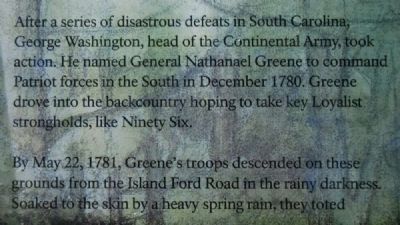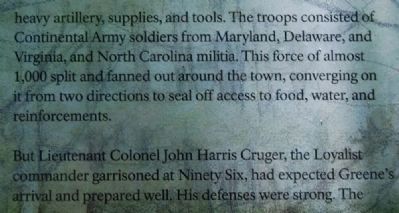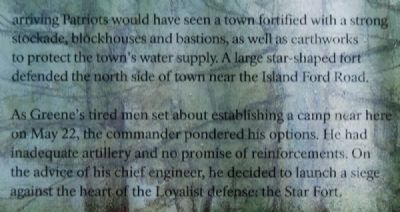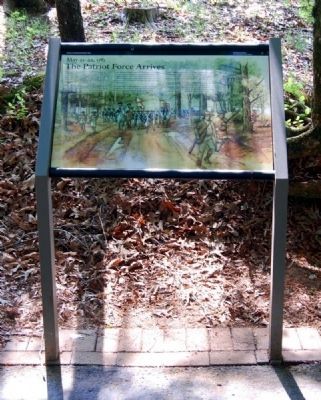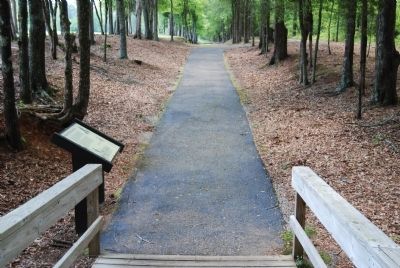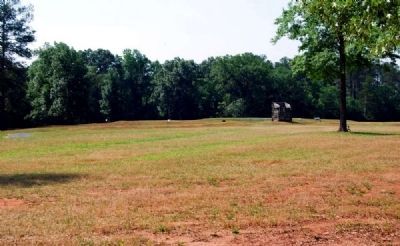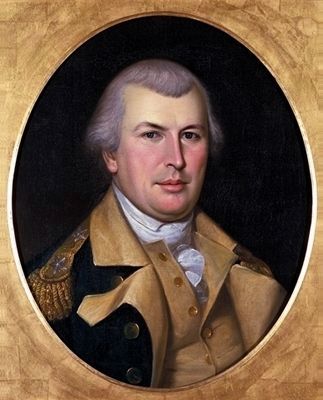Ninety Six in Greenwood County, South Carolina — The American South (South Atlantic)
The Patriot Force Arrives
May 21-22, 1781
After a series of disastrous defeats in South Carolina, George Washington, head of the Continental Army, took action. He named General Nathanael Greene to command Patriot forces in the South in December 1780. Greene drove into the backcountry hoping to take key Loyalist strongholds, like Ninety Six.
By May 22, 1781, Greene's troops descended on these grounds from the Island Ford Road in the rainy darkness. Soaked to the skin by a heavy spring rain, they toted heavy artillery, supplies, and tools. The troops consisted of Continental Army soldiers from Maryland, Delaware, and Virginia, and North Carolina militia. This force of almost 1,000 split and fanned out around the town, converging on it from two directions to seal off access to food, water, and reinforcements.
But Lieutenant Colonel John Harris Cruger, the Loyalist commander garrisoned at Ninety Six, had expected Greene's arrival and prepared well. His defenses were strong. The arriving Patriots would have seen a town fortified with a strong stockade, blockhouses and bastions, as well as earthworks to protect the town's water supply. A large star-shaped fort defended the north side of town near the Island Ford Road.
As Greene's tired men set about establishing a camp near here on May 22, the commander pondered his options. He had inadequate artillery and no promise of reinforcements. On the advice of his chief engineer, he decided to launch a siege against the heart of the Loyalist defense: the Star Fort.
Erected 2009 by National Park Service.
Topics. This historical marker is listed in these topic lists: Forts and Castles • Patriots & Patriotism • War, US Revolutionary. A significant historical month for this entry is May 1886.
Location. 34° 8.865′ N, 82° 1.134′ W. Marker is in Ninety Six, South Carolina, in Greenwood County. Marker is on South Cambridge Street. Marker is located at near the end of the forest walking trail in Ninety Six National Park. Touch for map. Marker is in this post office area: Ninety Six SC 29666, United States of America. Touch for directions.
Other nearby markers. At least 10 other markers are within walking distance of this marker. Trader with Pack Horse (a few steps from this marker); Island Ford Road (a few steps from this marker); The Patriots Lay Siege to the Star Fort (within shouting distance of this marker); The British Fortifications (within shouting distance of this marker); a different marker also named The Patriots Lay Siege to the Star Fort (within shouting distance of this marker); Patriot Soldier (within shouting distance of this marker); The Artillery (within shouting distance of this marker); Environmental Change From Forest to Park (about 300 feet away, measured in a direct line); First Parallel (about 300 feet away); Second Parallel (about 300 feet away). Touch for a list and map of all markers in Ninety Six.
More about this marker. The marker shown in Photo 4 is the new version of the marker.
Also see . . .
1. Ninety Six National Historic Site (U.S. National Park Service). Here settlers struggled against the harsh backcountry to survive, Cherokee Indians hunted and fought to keep their land, two towns and a trading post were formed and abandoned to the elements, and two Revolutionary War battles that claimed over 100 lives took place here. (Submitted on September 7, 2008, by Brian Scott of Anderson, South Carolina.)
2. Nathanael Greene. Nathanael Greene (August 7, 1742 – June 19, 1786) was a major general of the Continental Army in the American Revolutionary War. (Submitted on September 7, 2008, by Brian Scott of Anderson, South Carolina.)
3. Loyalist Institute: Memorial of John Harris Cruger of New York. To the Commissioners appointed by Act of Parliament for enquiring into the Losses & Services of the American Loyalists, the Memorial of Lt. Col. J.H. Cruger. (Submitted on September 7, 2008, by Brian Scott of Anderson, South Carolina.)
4. Ninety Six National Historic Site. The historic district of Ninety Six National Historic Site contains numerous historical features associated with the economic and social development of the colonial South Carolina back country. (Submitted on July 9, 2010, by Brian Scott of Anderson, South Carolina.)

Photographed By Brian Scott, September 5, 2008
5. Original The Patriot Force Arrives Marker
On May 22, 1781, a Patriot army, commanded by Major General Nathanael Greene, marched down Island Ford Road and began the siege of Ninety Six. Greene's army consisted of 984 men from Maryland, Virginia, Delaware, and North Carolina and was later joined by Lieutenant Colonel Henry Lee's Virginia Legion and South Carolina militia.
Loyalist militia from New York, New Jersey, and South Carolina commanded by Lieutenant Colonel John Harris Cruger and numbering about 550 men, garrisoned the Ninety Six fort. Although the Loyalists were outnumbered, they held the strongest British outpost in backcountry South Carolina. Greene reported that "the fortifications are so strong and the garrison so large and so well fortified that our Success is very doubtful..."
Loyalist militia from New York, New Jersey, and South Carolina commanded by Lieutenant Colonel John Harris Cruger and numbering about 550 men, garrisoned the Ninety Six fort. Although the Loyalists were outnumbered, they held the strongest British outpost in backcountry South Carolina. Greene reported that "the fortifications are so strong and the garrison so large and so well fortified that our Success is very doubtful..."
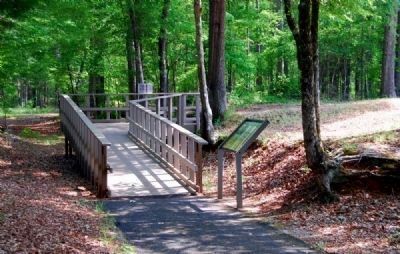
Photographed By Brian Scott
6. The Patriot Force Arrives Marker
Marker on bridge reads:
This Bridge was Constructed with 100%
Recycled Plastic Lumber Provided by a
---------------------------
2008 Unilever Recycling at
Work Sustainable Grant
---------------------------
with Volunteer Labor Provided by
---------------------------
The Building Construction Class
at Piedmont Technical College
Recycled Plastic Lumber Provided by a
---------------------------
2008 Unilever Recycling at
Work Sustainable Grant
---------------------------
with Volunteer Labor Provided by
---------------------------
The Building Construction Class
at Piedmont Technical College
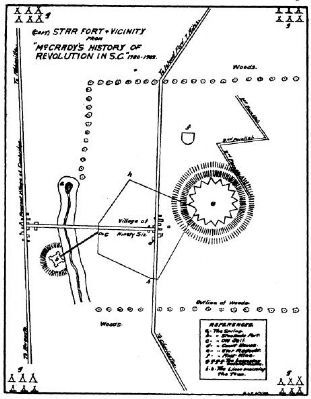
Photographed By National Register Nomination Form
8. Ninety Six and Star Fort
This sketch of ninety Six and Star Fort was published in 1822 in Johnson's Life of Nathanael Green and has since been copied in several publications. Roberts said the design resembled a child's drawing of a seated cat, with the fort as the hear, the village as the body, and the covered passage to the small stockade as the tail.
Credits. This page was last revised on June 16, 2016. It was originally submitted on September 7, 2008, by Brian Scott of Anderson, South Carolina. This page has been viewed 959 times since then and 16 times this year. Photos: 1, 2, 3, 4. submitted on July 9, 2010, by Brian Scott of Anderson, South Carolina. 5. submitted on September 7, 2008, by Brian Scott of Anderson, South Carolina. 6. submitted on July 9, 2010, by Brian Scott of Anderson, South Carolina. 7. submitted on September 7, 2008, by Brian Scott of Anderson, South Carolina. 8. submitted on May 9, 2010, by Brian Scott of Anderson, South Carolina. 9. submitted on July 9, 2010, by Brian Scott of Anderson, South Carolina. 10. submitted on May 10, 2010, by Brian Scott of Anderson, South Carolina. 11. submitted on July 9, 2010, by Brian Scott of Anderson, South Carolina. • Craig Swain was the editor who published this page.
